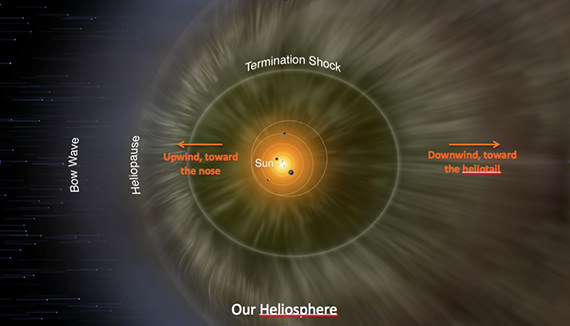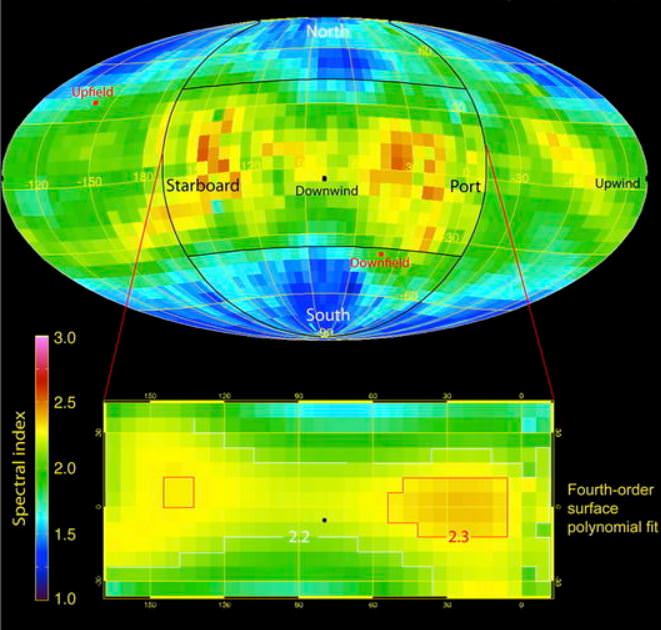Our Solar System is moving through interstellar space and scientists have long thought that the “bubble” around our Solar System – called the heliosphere – might have a tail, similar to how a comet has a tail or how other stars have astrospheres. But that has all been conjecture…. until now.
The IBEX spacecraft (Interstellar Boundary Explorer) has now seen the tail and has mapped out its structure. IBEX scientists were surprised to see the tail has twists and turns, with four separate “lobes,” making it appear somewhat like a four-leaf clover. This downwind region of the heliosphere is called the heliotail.
“Scientists have always presumed that the heliosphere had a tail,” said Eric Christian, IBEX mission scientist, speaking during a Google+ Hangout announcing the new findings. “But this is actually the first real data that we have to give us the shape of the tail.”
IBEX measures the neutral particles created by collisions at the solar system’s boundaries. This technique, called energetic neutral atom imaging, relies on the fact that the paths of neutral particles are not affected by the solar magnetic field. Instead, the particles travel in a straight line from collision to IBEX. Consequently, observing where the neutral particles came from describes what is going on in these distant regions.
“By collecting these energetic neutral atoms, IBEX provides maps of the original charged particles,” said David McComas, lead author on the team’s paper and principal investigator for IBEX at Southwest Research Institute. “The structures in the heliotail are invisible to our eyes, but we can use this trick to remotely image the outermost regions of our heliosphere.”
What they found was unexpected, McComas said.
“By very carefully assembling the statistical observations from the first three years of IBEX data we’ve been able to fill in what we couldn’t see before,” McComas said during the Hangout, “and what we found was that the heliotail was a much larger structure with a much more interesting configuration.
What they found was a tail that appears to have a combination of fast and slow moving particles. There are two lobes of slower particles on the sides, with faster particles above and below. The entire structure is twisted from the pushing and pulling of magnetic fields outside the solar system. McComas likened it to a how a beach ball might twist around if it was attached to a bungee cord.

The IBEX scientists speaking during the Hangout today said this new information will help us understand what the Voyager spacecraft may encounter as they reach the edge of our Solar System.
“IBEX and Voyager are incredibly complimentary missions,” said Christian. “I’ve often said that IBEX is like an MRI, where it can take an image to understand the big picture of what is going on, where the Voyagers are like biopsies, where we can see what is going on in the local area.”
This was the first time a NASA used a Google+ Hangout to broadcast a press briefing. You can watch the full Hangout below:
You can read David McComas’ blog post on the new findings here, and NASA’s press release here.


So which part of the structure are the Voyagers in? They’re headed mostly away from the tail, right? Does this help tell us when they’ll be in interstellar space?
I think they’re going almost perpendicular to the heliotail.
One of the linked article notes that Pioneer 10 is going into the tail, but it died 2003 so well before it could see it.
Meaning the remaining 3 crafts will miss the tail, FWIW telling the passage out.
We learn that our sun has a tail
As fast through the aether we sail
Like clover-shaped leaves
From strong solar breeze
The size of it makes me turn pale
what Daniel replied I’m shocked that any one can get paid $9020 in four weeks on the internet. did you look at this site link www.KEP2.com
You can spend a long time looking for the alleged 4-leaf clover in this analogy. Look at 1:30 in the video clip above “IBEX provides first view of the Solar System’s Tail”
Where is IBEX?
It’s somewhere in space. 😉
Very funny.
Don’t you think it would be interesting to know, and the info should have been included, whether it is in low earth orbit, high earth orbit, various Lagrange points, or… just out there somewhere?
Er… I did provide a link (underlined above) for the information you required.
No. Those are nice links but none of them that I’ve had the patience to wade through, answer my very simple question. Where is IBEX? How difficult can this be to say where it is??
I did not take you for a teenager with a short attention span! However, for your benefit, this is a copy & paste job of the relevant information from the link above:
Thank you, Ivan. Despite the crack about being a teenager. Which I’m very far from:-)
It would be interesting to detect similar heliospheres (stellarspheres) with tails around other stars.
LC
I think astronomers already have done: here, here, here, here (PDF), here (PDF), and here (PDF).
Who expected that? Ever since IBEX didn’t see the bow shock 2012, the more elliptic heliosphere has been proposed based on the then data (diminutive tail, if any). Now they have to add back a tail.
Though they seem to draw it too long, maybe in an effort to imitate the peacock. =D The missing bow shock would have been at double the Viking distances or ~ 230 AU vs ~ 100 AU, and the tail length is estimated as 4-5 times that at ~ 1 000 AU.